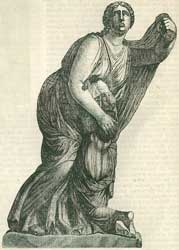Niobe
A daughter of Tantalus by the Pleiad Taygete or the Hyad Dione,1 or, according to others, a daughter of Pelops and the wife of Zethus or Alalcomeneus,2 while Parthenius relates quite a different story,3 for he makes her a daughter of Assaon and the wife of Philottus, and relates that she entered into a dispute with Leto about the beauty of their respective children. In consequence of this Philottus was torn to pieces during the chase, and Assaon fell in love with his own daughter; but she rejected him, and he in revenge burnt all her children, in consequence of which Niobe threw herself down from a rock.4

But according to the common story, which represents her as a daughter of Tantalus, she was the sister of Pelops, and married to Amphion, king of Thebes, by whom she became the mother of six sons and six daughters. Being proud of the number of her children, she deemed herself superior to Leto, who had given birth only to two children. Apollo and Artemis, indignant at such presumption, slew all the children of Niobe. For nine days their bodies lay in their blood without any one burying them, for Zeus had changed the people into stones; but on the tenth day the gods themselves buried them. Niobe herself, who had gone to Mount Sipylus, was metamorphosed into stone, and even thus continued to feel the misfortune with which the gods had visited her.5
Later writers, and especially the dramatic poets have greatly modified and enlarged the simple story related by Homer. The number and names of the children of Niobe vary very much in the different accounts, for while Homer states that their number was twelve, Hesiod and others mentioned twenty, Alcman only six, Sappho eighteen, Hellanicus six, Euripides fourteen, Herodotus four, and Apollodorus fourteen.6
According to Homer all the children of Niobe fell by the arrows of Apollo and Artemis; but later writers state that one of her sons, Amphion or Amyclas, and one of her daughters, Meliboea, were saved, but that Meliboea, having turned pale with terror at the sight of her dying brothers and sisters, was afterwards called Chloris, and this Chloris is then confounded with Chloris the daughter of Amphion of Orchomenos, who was married to Neleus.7

The time and place at which the children of Niobe were destroyed are likewise stated differently. According to Homer, they perished in their mother's house; and, according to Apollodorus, the sons were killed by Apollo during the chase on Mount Cithaeron (Hyginus8 says on Mount Sipylus), and the daughters by Artemis at Thebes, not far from the royal palace. According to Ovid, the sons were slain while they were engaged in gymnastic exercises in a plain near Thebes, and the daughters during the funeral of their brothers. Others, again, transfer the scene to Lydia,9 or make Niobe, after the death of her children, go from Thebes to Lydia, to her father Tantalus on Mount Sipylus, where Zeus, at her own request, metamorphosed her into a stone, which during the summer always shed tears.10
In the time of Pausanias11 people still fancied they could see the petrified figure of Niobe on Mount Sipylus. The tomb of the children of Niobe, however, was shown at Thebes.12
❧
Iconography
The story of Niobe and her children was frequently taken as a subject by ancient artists;13 but none of the ancient representations is more celebrated than the group of Niobe and her children which filled the pediment of the temple of Apollo Sosianus at Rome, and was found at Rome in the year 1583. This group is now at Florence, and consists of the mother, who holds her youngest daughter on her knees, and thirteen statues of her sons and daughters, independent of a figure usually called the paedagogus of the children. It is, however, not improbable that several of the statues which now compose the group, originally did not belong to it. Some of the figures in it belong to the most masterly productions of ancient art. The Romans themselves were uncertain as to whether the group was the work of Scopas or Praxiteles.14
Niobe and her children, struck by the arrows of Apollo and Artemis, are depicted on many Greek vases, among which the so-called Niobids krater or Argonauts krater (Louvre, Paris), a red-figure vase of ca. 435 BCE. This vase is one of the first on which curved lines are used to suggest a rolling landscape. They also frequently appear on murals and sarcophagi.
References
Notes
- Ovid. Metamorphoses vi, 174; Hyginus. Fabulae, 9.
- Eustathius on Homer, p. 1367.
- Of the Sorrows of Love, 33.
- comp. Scholiast on Euripides' Phoenician Women, 159.
- Homer. Iliad xxiv, 603-617; Pseudo-Apollodorus. The Library iii, 5.6; Ovid. Metamorphoses vi, 155 ff.; Pausanias. Description of Greece viii, 2, in fin.
- Pseudo-Apollodorus, l.c.; Ovid. Metamorphoses vi, 182; Aelian. Varia Historia xii, 36; Gellius, xx, 6; Scholiast on Euripides' Phoenician Women, 159; Eustathius on Homer, p. 1367; Hyginus. Fabulae, 11; Tzetzes on Lycophron, 520.
- Pseudo-Apollodorus, l.c.; Homer. Odyssey xii, 282; Pausanias. Description of Greece ii, 21, in fin.; v, 16.3.
- Fabulae, 9.
- Eustathius on Homer, p. 1367.
- Ovid. Metamorphoses vi, 303; Pseudo-Apollodorus, l.c.; Pausanias. Description of Greece viii, 2.3 Sophocles. Antigone, 823; Electra, 147.
- Description of Greece i, 21.5.
- Pausanias. Description of Greece ix, 16, in fin., 17.1; but comp. Scholiast on Euripides' Phoenician Women, 159.
- Pausanias. Description of Greece i, 21.5; v, 11.2.
- Pliny the Elder. Naturalis Historia xxxvi, 4.
Sources
- Aken, Dr. A.R.A. van. (1961). Elseviers Mythologische Encyclopedie. Amsterdam: Elsevier.
- Cooper, J.C., ed. (1997). Brewer's Book of Myth and Legend. Oxford: Helicon Publishing Ltd.
- Smith, William. (1870). Dictionary of Greek and Roman Biography and Mythology. London: Taylor, Walton, and Maberly.
This article incorporates text from Dictionary of Greek and Roman Biography and Mythology (1870) by William Smith, which is in the public domain.